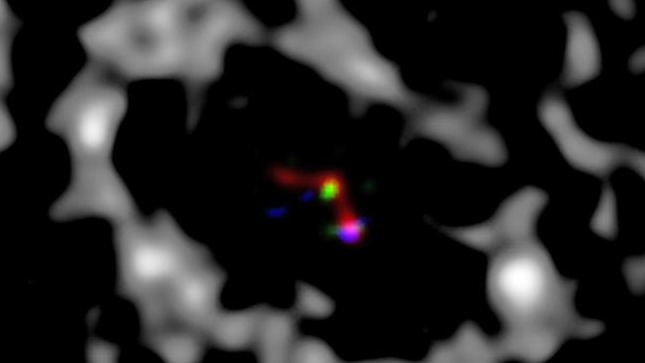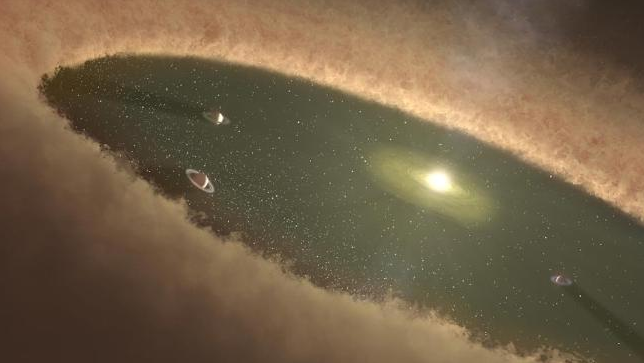It looks like you're using an Ad Blocker.
Please white-list or disable AboveTopSecret.com in your ad-blocking tool.
Thank you.
Some features of ATS will be disabled while you continue to use an ad-blocker.
share:
Other worlds found in the making. I just hope they turn out to be a better place than our current rock.
IT IS being hailed as a major breakthrough, a world-first and proof of a long-held theory.
Scientists in Australia and the US have captured the first-ever images of a planet in the making — and they’re a little excited.
None of the nearly 1900 planets previously discovered and confirmed outside our Solar System (called exoplanets) are in the process of formation.
Using the most sophisticated and largest telescopes in the world, the teams were able to observe the process by which a planet forms and grows.

The telltale signs, according to the research findings published in the journal Nature today, were the accumulation of dust and gas particles on the said star known as LkCa 15.
Artists impression below:

This new planet is located 450 light years away from Earth.
www.news.com.au... 22898978b8026a183271
IT IS being hailed as a major breakthrough, a world-first and proof of a long-held theory.
Scientists in Australia and the US have captured the first-ever images of a planet in the making — and they’re a little excited.
None of the nearly 1900 planets previously discovered and confirmed outside our Solar System (called exoplanets) are in the process of formation.
Using the most sophisticated and largest telescopes in the world, the teams were able to observe the process by which a planet forms and grows.

The telltale signs, according to the research findings published in the journal Nature today, were the accumulation of dust and gas particles on the said star known as LkCa 15.
Artists impression below:

This new planet is located 450 light years away from Earth.
www.news.com.au... 22898978b8026a183271
originally posted by: theantediluvian
a reply to: CaptainBeno
Impressive!
fixed link
Good work there, the original link nearly bugjiggered me.
Anyway I get the picture now, it's the red that's the forming planet around the star. So, what's all the grey stuff way out on the periphery that has white highlights, more planet forming material?
I don't get that as yet!
is anybody keeping track of how many days it takes?
...sorry, i had to.
...sorry, i had to.
Here's the article from the "horse's mouth", Stanford University: news.stanford.edu...
A couple of things I find notable:
1. The researchers designed their own imaging instrument to look for a characteristic planet formation signature.
2. The two main researchers are graduate students. If anything, this discovery should grant them their PhDs.
And of course it's great to see that this was an international collaboration.
A couple of things I find notable:
1. The researchers designed their own imaging instrument to look for a characteristic planet formation signature.
2. The two main researchers are graduate students. If anything, this discovery should grant them their PhDs.
And of course it's great to see that this was an international collaboration.
Let's push people, further away, from the "creation" theory.
This new planet is located 450 light years away from Earth.
How can a camera capture an object that's 450 light years away from Earth? Even if the camera was 1 light year closer, (which it's not) it still wouldn't "capture an object."
At some point, we're going to have to do more than just "wake up".
a reply to: JuJuBee
It can't. If they could, then surely they could take a really good image of the nearest star to us at around 4 LY, but they can't even do that. To take a picture of the nearest star would require a lens or mirror 625 kilometres in diameter. Astronomy now is done by mathemagics.
How can a camera capture an object that's 450 light years away from Earth?
It can't. If they could, then surely they could take a really good image of the nearest star to us at around 4 LY, but they can't even do that. To take a picture of the nearest star would require a lens or mirror 625 kilometres in diameter. Astronomy now is done by mathemagics.
originally posted by: GaryN
a reply to: JuJuBee
How can a camera capture an object that's 450 light years away from Earth?
It can't. If they could, then surely they could take a really good image of the nearest star to us at around 4 LY, but they can't even do that. To take a picture of the nearest star would require a lens or mirror 625 kilometres in diameter. Astronomy now is done by mathemagics.
There's a difference between resolving an object, and simply detecting it.
Besides, the most cutting-edge adaptive optics can actually resolve some stars into discs. www.gizmag.com...
I just find it amazing how we can theorize these things on our planet, but are then able to verify that it actually exists.
LOL, everyone knows it takes 7 days, then God will need a rest. At least that's what happened here on earth.
I can't really make up my opinion on this, is it real or fake? As I was reading through the comments of this thread I noticed that some people have
been saying that you would need a massive lense, which is one of the things we don't have, so how is this real?
a reply to: Foxxer
The findings, which was led by University of Arizona graduates Steph Sallum and Kate Follette, were only possible because of very specialised equipment.
These included the Large Binocular Telescope, or LBT– the world’s largest telescope, located on Arizona’s Mount Graham, and the University of Arizona’s Magellan Telescope and its Adaptive Optics System, MagAO, located in Chile.
Being able to crack the mystery was only possible because of the Large Binocular Telescope was purpose-built, using a novel imaging technique to sharpen the images, the paper says.
And yet we can't see the elusive PlanetX/Nibiru.
With that said...Nice find OP it is amazing what technology is allowing us to see.
With that said...Nice find OP it is amazing what technology is allowing us to see.
a reply to: tsurfer2000h
.......or not. Well, what "they" tell us at least.
I'm sure they keep a hell of a lot secret.
But, any thank buddy Cheers!
.......or not. Well, what "they" tell us at least.
I'm sure they keep a hell of a lot secret.
But, any thank buddy Cheers!
originally posted by: CaptainBeno
a reply to: tsurfer2000h
.......or not. Well, what "they" tell us at least.
I'm sure they keep a hell of a lot secret.
Graduate students keeping astronomy findings secret? Someone needs to have a word with them, tsk tsk tsk...
new topics
-
Results of the use of the Oreshnik missile system in Dnepropetrovsk
World War Three: 47 minutes ago -
Nigel Farage now the Most Favoured UK Politician
Regional Politics: 2 hours ago -
Little Johnny and Larry should team up
General Chit Chat: 8 hours ago -
Will Us use alien technology to fight in ww3?
World War Three: 9 hours ago
top topics
-
Elon Says It’s ‘Likely’ He Buys Tanking MSNBC
Political Ideology: 17 hours ago, 16 flags -
Little Johnny and Larry should team up
General Chit Chat: 8 hours ago, 5 flags -
Shane Gillis commercial
Jokes, Puns, & Pranks: 15 hours ago, 4 flags -
Will Us use alien technology to fight in ww3?
World War Three: 9 hours ago, 1 flags -
Nigel Farage now the Most Favoured UK Politician
Regional Politics: 2 hours ago, 1 flags -
Results of the use of the Oreshnik missile system in Dnepropetrovsk
World War Three: 47 minutes ago, 1 flags
active topics
-
Well we know Putins ICBMs won't fail in their silos
World War Three • 181 • : andy06shake -
Results of the use of the Oreshnik missile system in Dnepropetrovsk
World War Three • 7 • : CriticalStinker -
Gaetz withdraws from attorney general consideration
US Political Madness • 26 • : BernnieJGato -
Nigel Farage now the Most Favoured UK Politician
Regional Politics • 5 • : gortex -
Jaguar Rebrand Video Causes "WTF?" Moment - Seriously Weird
Automotive Discussion • 22 • : JAY1980 -
Will Us use alien technology to fight in ww3?
World War Three • 10 • : andy06shake -
Why isn't Psychiatry involved?
Social Issues and Civil Unrest • 13 • : ADVISOR -
WATCH LIVE: US Congress hearing on UFOs, unidentified anomalous phenomena
Aliens and UFOs • 152 • : Lazy88 -
Biden's "Reckless" Decision To Escalate Russia-Ukraine War
World War Three • 123 • : BedevereTheWise -
Elon Says It’s ‘Likely’ He Buys Tanking MSNBC
Political Ideology • 74 • : andy06shake
